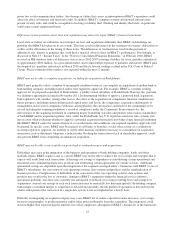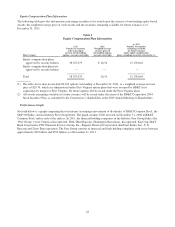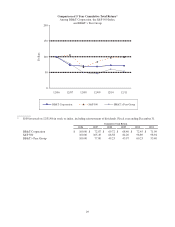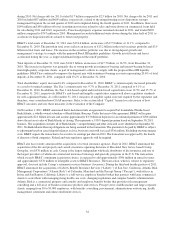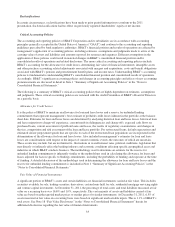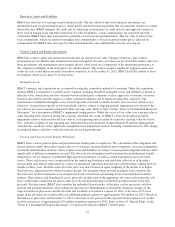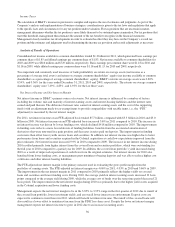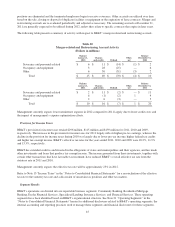BB&T 2011 Annual Report Download - page 35
Download and view the complete annual report
Please find page 35 of the 2011 BB&T annual report below. You can navigate through the pages in the report by either clicking on the pages listed below, or by using the keyword search tool below to find specific information within the annual report.
Derivative Assets and Liabilities
BB&T uses derivatives to manage various financial risks. The fair values of derivative financial instruments are
determined based on quoted market prices, dealer quotes and internal pricing models that are primarily sensitive to market
observable data. BB&T mitigates the credit risk by subjecting counterparties to credit reviews and approvals similar to
those used in making loans and other extensions of credit. In addition, certain counterparties are required to provide
collateral to BB&T when their unsecured loss positions exceed certain negotiated limits. The fair value of interest rate
lock commitments, which are related to mortgage loan commitments, is based on quoted market prices adjusted for
commitments that BB&T does not expect to fund and includes the value attributable to the net servicing fee.
Venture Capital and Similar Investments
BB&T has venture capital and similar investments that are carried at fair value. Changes in the fair value of these
investments are recorded in other noninterest income each period. In many cases there are no observable market values for
these investments and management must estimate the fair value based on a comparison of the operating performance of
the company to multiples in the marketplace for similar entities. This analysis requires significant judgment and actual
values in a sale could differ materially from those estimated. As of December 31, 2011, BB&T had $261 million of these
investments, which is less than 1% of total assets.
Intangible Assets
BB&T’s mergers and acquisitions are accounted for using the acquisition method of accounting. Under the acquisition
method, BB&T is required to record the assets acquired, including identified intangible assets, and liabilities assumed at
their fair value, which often involves estimates based on third party valuations, such as appraisals, or internal valuations
based on discounted cash flow analyses or other valuation techniques, all of which are inherently subjective. The
amortization of identified intangible assets is based upon the estimated economic benefits to be received, which is also
subjective. Acquisitions typically result in goodwill, which is subject to ongoing periodic impairment tests based on the
fair value of net assets acquired compared to their carrying value. Refer to Note 1 in the “Notes to Consolidated Financial
Statements” for a description of BB&T’s impairment testing process. While the excess of fair value over carrying value of
some reporting units narrowed during the economic downturn, the results of BB&T’s most recent annual goodwill
impairment analysis indicated that the fair value of each reporting unit exceeded its respective carrying value by at least
20%, with the exception of one reporting unit, which had allocated goodwill of approximately $3 million. Management
considers the sensitivity of the significant assumptions in its impairment analysis including consideration of a 10% change
in estimated future cash flows or the discount rate for each reporting unit.
Pension and Postretirement Benefit Obligations
BB&T offers various pension plans and postretirement benefit plans to employees. The calculation of the obligations and
related expenses under these plans requires the use of actuarial valuation methods and assumptions. Actuarial assumptions
used in the determination of future values of plan assets and liabilities are subject to management judgment and may differ
significantly if different assumptions are used. The discount rate assumption used to measure the postretirement benefit
obligations is set by reference to published high-quality bond indices, as well as certain hypothetical spot-rate yield
curves. These yield curves were constructed from the underlying bond price and yield data collected as of the plan’s
measurement date and are represented by a series of annualized, individual discount rates with durations ranging from six
months to thirty years. Each discount rate in the curve was derived from an equal weighting of the double A or higher
bond universe, apportioned into distinct maturity groups. For durations where no bond maturities were available, the
discount rates for these maturities were extrapolated based on historical relationships from observable data in similar
markets. These indices and hypothetical curves give only an indication of the appropriate discount rate because the cash
flows of the bonds comprising the indices and curves do not match the projected benefit payment stream of the plan
precisely. For this reason, BB&T also considers the individual characteristics of the plan, such as projected cash flow
patterns and payment durations, when setting the discount rate. Management evaluated the sensitivity changes in the
expected return on plan assets and the discount rate would have on pension expense for 2012. A decrease of 25 basis
points in the discount rate would result in an additional pension expense of approximately $14 million for 2012. Based on
the balance of plan assets on December 31, 2011, a decrease of one percent in the expected return on plan assets would
result in an increase of approximately $25 million in pension expense for 2012. Refer to Note 14 “Benefit Plans” in the
“Notes to Consolidated Financial Statements” for disclosures related to BB&T’s benefit plans.
35


